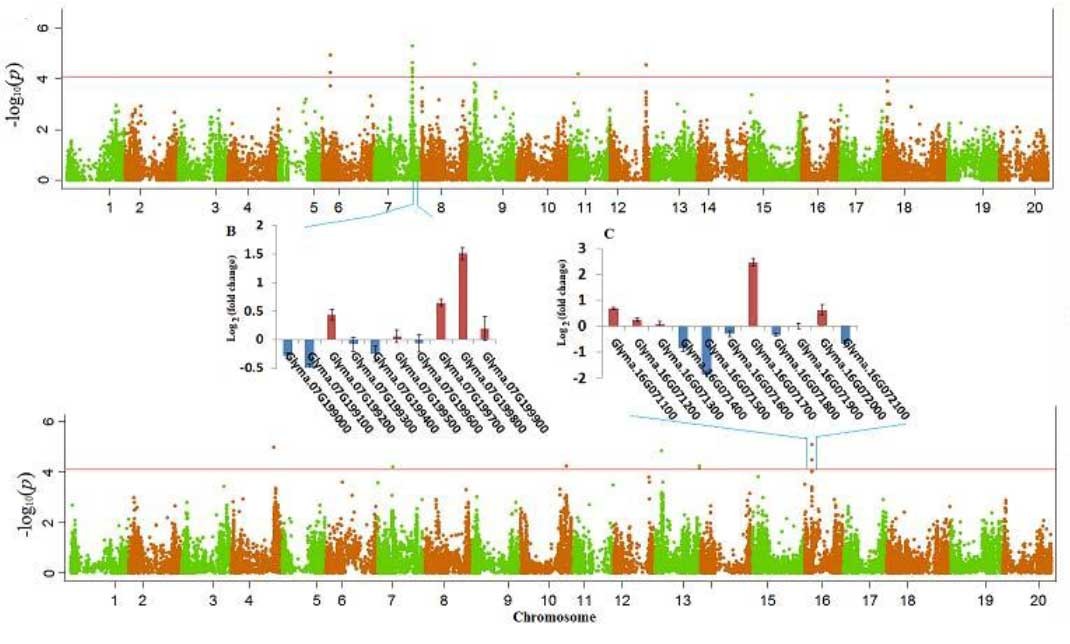博文
Plant Biotechnol J:GWAS解析大豆抗白霉病的遗传结构
||
Integrating GWAS and gene expression data for functional characterization of resistance to white mold in soybean
First author: Zixiang Wen; Affiliations: Michigan State University (密歇根州立大学): East Lansing, USA
Corresponding author: Dechun Wang
White mold (白霉) of soybean, caused by Sclerotinia sclerotiorum (Lib.) de Bary (核盘菌), is a necrotrophic fungus (死体营养型真菌) capable of infecting a wide range of plants. To dissect the genetic architecture of resistance to white mold, a high‐density customized single nucleotide polymorphism (SNP) array (52,041 SNPs) was used to genotype two soybean diversity panels. Combined with resistance variation data observed in the field and greenhouse environments, genome‐wide association studies (GWAS) were conducted to identify quantitative trait loci (QTL) controlling resistance against white mold. Results showed that 16 and 11 loci were found significantly associated with resistance in field and greenhouse, respectively. Of these, 8 loci localized to previously mapped QTL intervals and 1 loci had significant associations with resistance across both environments. The expression level changes of genes located in GWAS‐identified loci were assessed between partially resistant and susceptible genotypes through a RNA‐seq analysis of the stem tissue collected at various time points after inoculation (接种). A set of genes with diverse biological functionalities were identified as strong candidates underlying white mold resistance. Moreover, we found that genomic prediction models outperformed predictions based on significant SNPs. Prediction accuracies ranged from 0.48 and 0.64 for disease index measured in field experiments. The integrative methods, including GWAS, RNA‐seq and genomic selection (GS), applied in this study facilitated the identification of causal variants, enhanced our understanding of mechanisms of white mold resistance, and provided valuable information regarding breeding for disease resistance through genomic selection in soybean.
核盘菌是一种死体营养型真菌,能够引起大豆白霉,并且能够侵染很多植物物种。为了解析大豆对于白霉抗性的遗传结构,作者构建了一个包含52,041个SNPs的高密度遗传图谱用以对两种大豆多态性进行基因分型。结合在大田和温室观测到的抗性数据,作者利用全基因组关联分析GWAS鉴定控制大豆对于白霉抗性的数量性状位点QTL。结果显示分别有16个和11个位点在大田和温室环境下与抗性显著相关。其中,有8个位点定位于之前已经报道过的QTL区间内,1个位点在两个环境中均与抗性显著相关。作者取样了部分抗性和易感基因型接种后多个时间点茎组织,并通过RNA-seq评估了GWAS鉴定的位点基因表达水平上的变化。作者鉴定了一系列不同功能的基因作为白霉抗性的候选基因。此外,作者发现通过基因组预测的结果要比基于SNPs预测的要效果更好。对于大田试验中测量的疾病指数预测精度从0.48到0.64不等。在本研究中所采用的结合GWAS、RNA-seq和基因组选择的综合方法促进了对于相关基因的鉴定,增强了我们对于白霉抗性机制的理解,并提供了通过基因组选择对于大豆进行疾病抗性育种的可贵信息。
通讯:Dechun Wang (https://msu.edu/~wangdech/Index.html)
�
�个人简介:1979-1983年,华中农业大学,学士;1992-1994年,密歇根州立大学,硕士;1994-1998年,密歇根州立大学,博士。
研究方向:大豆育种与遗传学;大豆分子遗传学;分子技术在植物育种中的应用
doi: https://doi.org/10.1111/pbi.12918
Journal: Plant Biotechnology Journal
First Published date: 12 March, 2018
(P.S. 欢迎关注微信公众号:微信号Plant_Frontiers)
https://wap.sciencenet.cn/blog-3158122-1104957.html
上一篇:Plant Biotechnol J:葡萄基因转拟南芥提升植物生物量和生殖产量
下一篇:CRIT REV PLANT SCI:人工miRNA介导植物苯丙素的生物合成
全部作者的其他最新博文
- • Plant Physiology:CsMADS3促进柑果中的叶绿素降解和类胡萝卜素合成(华中农业大学)
- • Molecular Plant:LBD11-ROS反馈调节作用于拟南芥的维管形成层增殖和次生生长(浦项科技大学)
- • Science Advances:根结线虫通过调控植物的CLE3-CLV1模块,促进侵染进程(日本熊本大学)
- • Nature Communications:油菜素内酯参与植物营养生长期转变的分子机制解析(浙江农林大学)
- • Current Biology:光合作用产生的蔗糖驱动侧根“生物钟”(德国弗莱堡大学)
- • PNAS:花同源异型基因在叶中被抑制、花中被激活的分子机制(南卡罗来纳大学)

